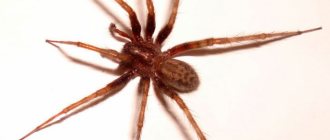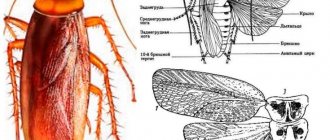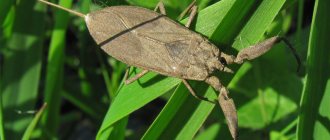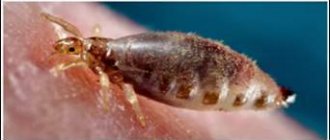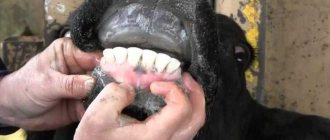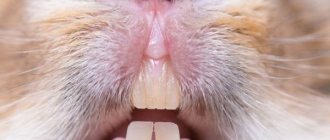The legs of arachnids have a very complex structure and a unique structure; they consist of a large number of different segments and are attached to the cephalothorax. All limbs end in a paw, thanks to which arthropods can move and hold securely on any surface. In certain varieties, the chelicerae and pedipalps are highly developed.
Number of legs in spiders
The spider has 8 legs, but we must not forget that the class of arachnids includes about 40 thousand species, divided into 3 subspecies. They all differ in lifestyle, appearance and size. Their body has 2 parts: the belly and the cephalothorax, which are connected by a small tube.
The spider's legs are covered with small villi; on the foot of one leg there can be up to 3 thousand of them. The abdominal limbs are located on the cephalothorax. There are spines at the end of all legs, with the help of which the spider easily moves along the web. Between the spines there is a claw-shaped appendage; in certain varieties there is a claw instead. The legs consist of various segments:
- hip and knee area;
- trochanters;
- paws;
- shins;
- heel and pelvis.
The claw part is not a true segment, since in certain animals it is not separated from the tarsus. The hind and front legs are the largest. The second pair is the shortest, the third has an average length.
In many species, the approximate size of the legs is about 3 cm, in others it varies between 20-40 cm. There are species of arachnids that catch their prey with the first and second pair of limbs, because they are more developed and can be longer than others. The size of the spider's legs will depend on the place of residence and lifestyle characteristics. Apart from movement, the limbs do not perform any other functions, therefore they are walking. Taking into account the species, the size of the spider can vary between 0.3-12 cm, and the paw span can be up to 40 cm.
Having considered how many legs a spider has, it should be noted that their number differs from the number of legs in insects. Arachnids have 8, insects have 6. All have 6 joints. When counting, it turns out that they have 48 tribes.
Complex mouthparts
The oral cavity of arachnids is equipped with chelicerae; as already mentioned, this is the first pair of head limbs in arthropods. What are they needed for? Since they are an integral part of the oral apparatus, their main task is to crush, grind or pierce food. The appearance depends on the type of animal; chelicerae can look like claws, hooks or needles. These features depend on the type of oral cavity.
Here are some types of oral apparatus:
- Gnawing (barn mites). The chelicerae are large and claw-like.
- Piercing-sucking (ticks whose diet includes plants or animal blood). Chelicerae, accordingly, have a thinner shape, without teeth, resembling a hollow tube.
In spiders, chelicerae have a claw-shaped end segment on which the venom gland duct opens.
Difference from insects
The spider belongs to the class of arachnids, it is not an insect . Characteristic features of this type:
- The main difference between arachnids and insects is that the last 6 legs are located on the chest, and not on the cephalothorax. In addition to external differences, animals have different structures of internal organs.
- Centipedes are also not insects, since they belong to a separate species.
- If we compare the body structure of arachnids with other creatures, it can be more closely related to a scorpion.
Spiders that live in apartments cannot harm the human body. You need to pay attention to sanitation conditions. Animals live in houses where there is enough food to remove them, it is necessary to get rid of the main cause of the invasion.
How many legs does a spider have?
The correct answer is how many legs does a spider have?
The world of arachnids includes up to 42 thousand individuals, which are divided into 3 suborders. Each suborder has its own differences in size, appearance and lifestyle. The body of animals consists of two sections: the cephalothorax and abdomen, connected by a small tube.
The spider has 8 legs covered with hairs.
There are up to 2 thousand villi on the foot of one paw. All limbs are on the cephalothorax. At the tip of each leg there are spines or jagged claws, thanks to which the spider moves easily across the web. Between the claws there is a claw-like appendage (sticky pad). Some species have claws instead of claws.
The limbs consist of 7 segments:
- trochanters;
- knee and femur;
- pelvic and calcaneal segments;
- shins;
- paws.
The claw segment does not belong to the true segment, because in some individuals it is not separated from the paw. The front and back pair of legs are the longest. The second pair of limbs is the smallest, the third is the middle one. In most species, the average size of the limbs is 2 cm, in others it can vary from 15 to 35 cm.
There are species of spiders that catch prey with the first and second pairs of legs, so they are highly developed and have grown longer than others. How long and thick a spider’s legs are depends on its habitat and lifestyle.
Apart from movement, the limbs do not perform any other functional tasks, therefore they are walking. Depending on the variety, the size of the animal can be from 0.4 to 10 cm, and the leg span can reach 35 cm.
Insects differ from spiders in the number of legs. Spiders have eight legs, while insects have six. Each of them has 6 joints. When counting, it turns out that the arthropod has 48 knees.
Distinctive features
Spider - belongs to the order of arachnids from a separate class of animals. It is not considered an insect.
Distinctive features:
- If we compare the body structure of a spider with other creatures, it is more similar to a scorpion.
- Millipedes and similar animals are not insects. Just like spiders, they are classified into a separate class.
- The main distinguishing feature of insects from spiders, which is noticeable externally, is the presence of 6 legs located on the thoracic region, and not on the cephalothorax. In addition to external differences, individuals differ in the internal structure of the body.
Small spiders living in the house are not capable of harming human health. It is necessary to pay attention to sanitary conditions if there are too many of them. Spiders will live where there is enough food to get rid of them, you need to eliminate the root cause of their appearance.
Purpose of the limbs
All arachnids have legs that perform the same tasks, and it doesn’t matter what species the individual belongs to. The animal moves thanks to its walking leg, so it is considered the main one.
The method of movement and speed of an arthropod can be different, as it depends on the structure and length of the limbs. The spider is capable of walking sideways, jumping far in length, and running quickly, developing impressive speed.
The forelimbs allow the predator to:
- Capture and firmly hold caught prey.
- Determine whether the caught prey is suitable for food or not.
- Weave a cocoon and create a web, as well as straighten and comb it.
- Place your children on your back and throw them out of there. In this case, the discharge occurs over long distances.
- Move along the substrate.
- Dig holes.
- Fight against predators.
The small hairs that cover the limbs allow the spider to touch and experience the world around it. Thanks to them, he smells, hears sounds, and orients himself well in space.
Before starting to move in an unfamiliar area, he first shuffles his paws in front of him, and only then moves.
Chelicerae and pedipalps
Some people claim that the spider has 10 legs. This confusion arises due to the chelicerae and pedipalps located on the front of the animal's cephalothorax. They are quite long and look like legs.
Their functions:
- Chelicerae - located in front of the oral apparatus, consist of 3 parts, similar to short claws. The claw finger of the outer part is movable. In some individuals, this mobile finger has the shape of a claw or a sharp appendage consisting of two segments. Thanks to this structure, the spider pierces the cover of its prey.
- The pedipalps are the second pair of limbs and consist of several parts. The main part has a chewing outgrowth, with the help of which the animal kneads its prey. The remaining segments look like tentacles.
The task of the pedipalps and chelicerae is to grind prey, chew and knead food. Poisonous individuals inject poison into the victim using chelicerae.
When the victim dies, the spider injects a small portion of saliva into it, after which all the insides turn into mush. He sucks out this pulp using a sucking stomach. The stomach works on the principle of a pump. Fertilization of females occurs through the pedipalps.
A large number of spiders in the wild may have four, five or six legs rather than eight. Arthropods lose or injure their limbs in battles with enemies, so for a full life, hunting, reproduction and other actions, 6 legs are enough for them; the 8th pair is a reserve. In place of lost legs, new ones do not grow.
Hunting Acumen
A spider never gets caught in its own web, no matter how many legs it has. Circular spider threads are covered with an adhesive substance. It is in them that the potential victim becomes entangled. The spider itself moves along radical smooth threads coming from the center of the web.
When prey becomes entangled in the nets, one of the threads becomes taut. This helps the spider determine which part of the huge web it is on.
The main purpose of the paws
All spiders have limbs that perform the same function, and it makes no difference what species the individual belongs to. They move using their walking paw, which is their main one. The method of movement and speed of arachnids may differ, as it depends on the structure and size of the legs . The forelimbs help arthropods:
- Determine whether the prey is suitable as food.
- Grasp and hold the victim tightly.
- Place your babies on the back and throw them out of there. Moreover, they throw children over very long distances.
- Make a cocoon and create a web.
- Resist attacks from predators.
- Dig holes.
- Move across the surface.
Small hairs on the legs help animals sense touch, learning about the external environment. With their help, they are well oriented in space, can hear sounds and smell. Before starting to move through unfamiliar territory, they first move their limbs in front of them, and only then move.
Limb functions
The main function of the legs is to provide the spider with the ability to move. The spider's record speed is 3.5 km per hour. The hairs that cover the paws are sensors. Some types of hairs are even sensitive to chemical elements. Others are able to “hear” the slightest vibration in the air, helping the spider prepare for the appearance of a prey or predator. The paws contain a complex chemical analyzer that can identify a large number of odors. These analyzers are very important for reproduction because they allow males to identify females of their species, detect and track their pheromone trail, and help them distinguish males from prey.
The front pair of limbs of the spider performs many functions: capturing and holding prey; determining the suitability of prey for food; weaving cocoons and webs; putting babies on their backs and throwing them off; movement on the substrate; digging a hole. Spiders use their front legs to fight predators.
Pedipalps and chelicerae
When counting how many legs a spider has, it is considered that arachnids have 10 legs. This is due to the pedipalps and chelicerae, which are located in front of the animal’s cephalothorax. They are quite long and look like paws. Their main task:
- The pedipalps are the second pair of legs, consisting of several segments. On the head part there is a chewing outgrowth with which the spider grinds its prey. The rest resemble a tentacle.
- Chelicerae are located near the mouth and have 3 parts that look like small claws. The outermost finger is movable. In certain species it has the shape of a claw or a pointed process, which consists of 2 parts. Due to this structure, the animal breaks through the prey's cover.
The task of the chelicerae and pedipalps is to grind prey, knead and chew it. Poisonous spiders, thanks to chelicerae, inject a toxic substance. When the victim dies, a certain amount of saliva is injected into it, after which the insides acquire a mushy consistency. The spider consumes the resulting pulp as food thanks to its sucking stomach. Fertilization of females occurs through the pedipalps.
Many arachnids may have fewer legs in their natural environment. They lose their legs in battles with predators, so for a full life, 6 limbs are enough for them, the eighth pair being a spare one. New paws do not grow in place of lost paws.
Modifications of chelicerae and pedipalps in arachnids
The body of arachnids includes a cephalothorax bearing 6 pairs of limbs, and an abdomen. The two anterior pairs are adapted for grasping and crushing food - they are called chelicerae, and the pedipalps, which also help knead and crush food. The first are located in front of the oral cavity and often look like short claws.
Chelicerae of arachnids, as a rule, consist of 3 segments, the terminal segment performs the task of a movable claw finger. In rare cases, chelicerae may end with a movable tool in the form of a claw or have the form of two-part appendages with a sharply jagged edge, with which one can pierce the integument of the victim.
The limbs of the second pair, called pedipalps, consist of several segments, the main one of which has a special chewing outgrowth that helps knead food. The remaining segments look like tentacles. For example, the pedipalps of scorpions are represented by powerful long claws; in some spiders they look like ordinary legs.
Longest limbs
A rare species of giant spiders, Heteropod Maxima, lives in Asia. The span of its limbs can be more than 40 cm. This species lives in caves in the Khammouan region. Also long limbs have:
- Hunter. The size of the limbs is more than 32 cm. This species can cover about one meter in a second. When it appears, a ticking sound is heard.
- Goliath tarantula. Lives in the tropics of South America. The weight of the animal reaches 180 g, the size of the legs is 16 cm. It is the largest after Heteropod Maxim. The lifespan of males is no more than 7 years, females - up to 16 years.
- Tegenaria. Lives in people's homes all over the world, limbs are 8−14 cm long.
- Baboon giant. One of the types of tarantulas. Body length - up to 14 cm, legs - up to 22 cm.
- Camel spider. It lives in the desert, can move at speeds of up to 3 km/h, defending itself from predators, and makes a squeaking sound, this distinguishes it from other species. Size - up to 9 cm, leg length - up to 32 cm. Belongs to the class of the phalanges suborder. Lives up to four years.
- Nephila. These individuals are also known as the golden spider or tree spider. The length of females can reach up to 17 cm. They weave webs measuring more than one meter.
- Crab spider. The paws of these individuals resemble the claws of a crab in appearance, which is why they received the corresponding name. Lives in the crevices of trees. The length is up to 26 cm, there are villi on the body, and spines on the limbs.
- Colombian tarantula. Size including limbs - up to 25 cm. Lifespan of males - up to 4 years, females - up to 20 years.
- Brazilian tarantula. Often kept at home as an exotic animal. The female’s weight is up to 120 g, size is 14 cm, limb length is up to 36 cm. Life time is about 29 years.
The structure of spider legs and their sizes
Each of the spider's limbs consists of seven parts:
- pelvic joint;
- short trochanter;
- oblong femoral part;
- knee element;
- shins;
- calcaneal joint;
- paws.
Each insect's foot ends with two or three nails.
Thanks to them, the spider weaves a web and can move along it. In addition, these claws help the insect stay steady on ceilings and walls. Between the nails there are special pads that contain a special sticky substance. As a rule, the limbs of spiders are covered with hairs protruding from the body or tightly adjacent to it. This hair in spiders acts as a tactile and sensory tool.
Many species of arachnids have hard hairs on the calcaneal joint of the fourth pair of limbs. The spider needs them to “comb” its web. The thickness and length of an insect's legs depends on its lifestyle. The spider's limbs are always of unequal length. The longest front and rear legs are the longest, the middle legs are slightly shorter, and the last ones are short.
The average limb length for many arachnid species is approximately 20 millimeters. In large species, the length of the legs varies from 150 to 350 millimeters. For example, the length of the limbs of the Theraphosa Blonda spider from South America is 280 millimeters, and the Heteropoda Maxima spider from Laos is 300 millimeters.
Neighborhood with people
Certain species of arachnids live close to humans. They live in places where there is enough food. As a rule, insects are eaten, but the diet will depend on the type of spider . The most common houses are:
- Haymaker. Taking into account the subspecies, the length can vary between 3−12 mm. Moreover, his legs are 5 times longer than his body. It likes to make webs on windows, for which it is also called the window spider. To catch the prey, the animal needs to position itself upside down near the placed web. When prey becomes entangled in the net, the predator rushes towards it, bites it, and then injects poison.
- Tramp. They enter the house by accident. These spiders do not set up webs; they catch prey on the move. When everything edible is destroyed, the arthropod leaves the house, moving on.
- Brownie. This is a small yellow individual 6−12 mm long. There is a brown pattern on the body. Females are larger than males. Make a web in the form of a funnel.
Spiders appear in the house when there is high humidity and a large number of insects that rapidly multiply in these conditions and move from room to room: mosquitoes, fruit flies, beetles.
Sensitive Organs
Very important organs in arachnids are the chelicerae and pedipalps. The latter contain a large number of sensitive hairs, which respond especially quickly to various tactile irritations. These hairs are called trichobothria; in addition to the pedipalps, they are also found on the legs and the surface of the body. Trichobothria are needed to detect air vibrations.
In addition to the spider's chelicerae and pedipalps, there are other sensory organs - lyre-shaped organs for chemical sense and smell, as well as eyes, the number of which depends on the species. There can be 12, 10, 8, 6, very rarely 2. As a rule, spiders have four pairs of simple eyes, and of different sizes, some larger, others smaller.
Amazing facts
The world of spiders is very diverse. These are unique and charming animals:
- There is a separate subspecies of the spider family called phrynes. It includes approximately 60 individuals. They have certain characteristics, the main one being that they do not know how to weave a web. They have quite large legs, and the front jaws, intended for hunting, are very strong.
- Spiders have no skeleton, only a hard shell. Because of this structure, the size of all arachnids is small. There are no large specimens that are shown in movies. Otherwise, the animal would have died under its own weight.
- It has been proven that the web is stronger than steel and other metals that exist in the world. Scientists still cannot make it artificially.
- The number of eyes in spiders can range from 2 to 12, and not 8, as many people think.
- During the hunt, arthropods react to vibrations. They can be recreated using a violin. To lure the spider out of its hiding place, you just need to play the instrument.
- The population of Cambodia keeps the tarantula spider as a pet, consuming the arthropod as food, as it is a magnificent delicacy.
- All varieties of spiders make a web in the shape of a circle, and only the gladiator makes a square, and the web of the orb weaver can reach up to 8 m in size.
Most people are terrified of spiders. This fear is called arachnophobia. However, in reality, these small representatives of arthropods have much more reasons to be afraid of humans. Spiders are the most unusual animals living on Earth. They received such fame due to the features that nature gave them.
Physical Traits of Spiders
Arachnids, higher chelicerate arthropods, are often called insects, but this is incorrect. Not only do their legs and body segments make them different, but unlike insects, arachnids don't have wings, can't chew, and don't have antennae. Spiders have several body features that help them do some pretty amazing things. Since all spiders are predators, they have fangs that they use to paralyze or kill their prey - chelicerae, and pedipalps in males to transfer seminal fluid to the female.
Spiders have no teeth, so they cannot chew or swallow. The poison in their fangs not only paralyzes, but also liquefies the insides of the victim, which become the spider’s food. Spiders have things called spinners that produce silk. This silk is used by spiders to build their homes, catch prey for food, hide, protect their children and help them make their first journeys. Their bodies are also coated in oil, which prevents them from getting stuck on their silk like their prey.

